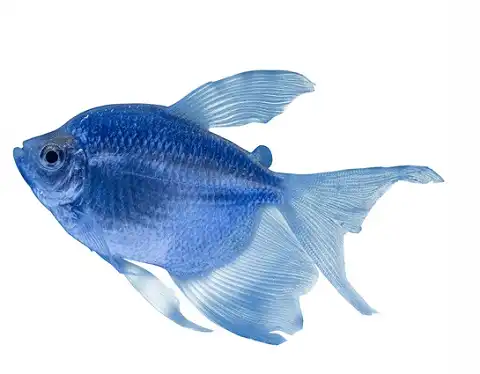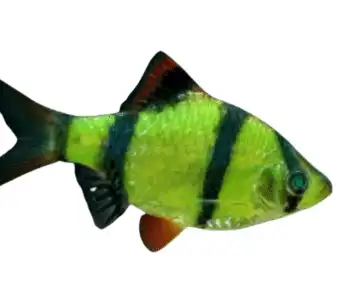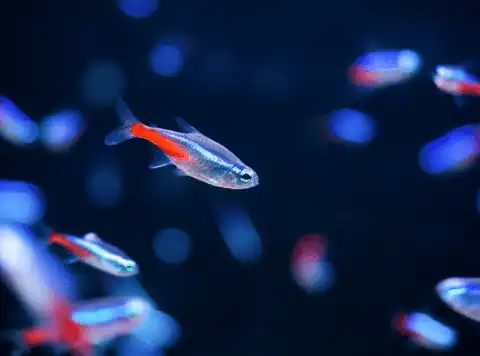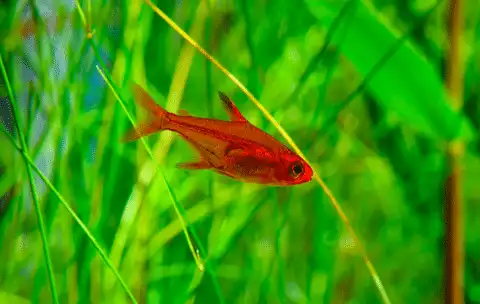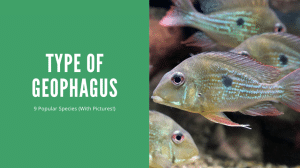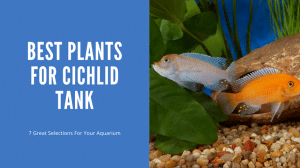Thank you for visiting! By the way… any links on this page that lead to products on Amazon and other stores/partners are affiliate links Aquarium Store Depot earns a commission if you make a purchase.
Over the past few years, GloFish have become some of the most popular beginner freshwater fish next to betta fish. It might seem like these easy-to-keep, neon-bright fish would make good tank mates for betta fish, but most are not. This might be due to size, aggression, or activity levels.
While GloFish are generally not considered a good tank mate for betta fish, there is one kind that could bring some excitement to the bottom of your betta tank! Keep reading to find out everything you need to know about GloFish with bettas which GloFish option is right for you.
Key Takeaways
- The only GloFish that is compatible with a betta are GloFish cories.
- Bettas have particular requirements that do not mix well with other GloFish, like tank size, aggression, and overall compatibility.
- Many GloFish, like tetras, are known nippers and are ill-suited for a slow-moving, long-finned betta.
- Another alternative to getting an entirely new fish species is getting a GloFish betta instead!
The Quick Answer – Glofish With Bettas Generally Don’t Work
The answer is mostly no. Many of the GloFish species available are incompatible with betta fish due to overactivity, aggression, or other behaviors that we will go over in this post. That being said, the GloFish corydoras are one of the most successful pairings.
What Are GloFish?
If you’ve ever gone to your local fish store, you might’ve seen blacked-out tanks with various fluorescent pink, yellow, orange, blue, and red fish. These are often different tetra, danio, barb, shark, and cory catfish species. You might find yourself asking what these fish are, whether or not they are safe to keep, and if they can be kept with your other community fish.
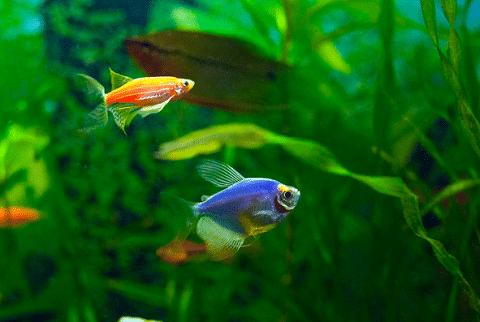
GloFish are genetically modified fish that have been fundamentally altered to express their trademarked bright colors. Contrary to popular belief, GloFish are not injected with artificial dyes and do not have genetic defects, though consumers should be wary of off-market fakes.
Instead, GloFish DNA has been altered to express certain colorful traits that get passed down from one generation to the next, meaning that their colors will never fade. It should be noted that breeding GloFish is trademarked and should not be intentionally tried in the aquarium setting.
In general, GloFish are no more or less ‘safe’ to keep than the wild-type variety of the given species. In most cases, bright individuals are just as hardy and adaptable as their regular-colored counterparts. There is a lot of discussion about the ethics of GloFish and what their adaptation could mean for the future of fishkeeping.
GloFish can safely be kept with a variety of tropical fish species. However, this isn’t usually done as they require special lighting, like a black light, for best viewing, which isn’t always best for other species. Because of this, many hobbyists set up a GloFish-only tank with a variety of compatible species.
Things To Consider
Pairing any fish with a male or female betta can be tricky. These are individualistic fish with varying temperaments. Whether or not your betta fish can be kept with other fish will depend solely on the personality of your fish.
There are a few ways to increase the likelihood of success, though.
Water Temperature
Betta fish enjoy a stable water temperature between 78 to 80° F. Most tropical fish options fall within this range, but some popular GloFish options, like zebra danios, do not.
Aquarium Size
No, betta fish cannot live in a bowl with GloFish. In fact, bettas should never be kept in anything smaller than a 5 gallon fish tank, with 3 gallons being regarded as the absolute minimum.
While a single male or female betta fish might be happy in a small tank, any addition of a tank mate will call for a larger tank due to the betta fish’s natural aggression and territorial behavior.
Unfortunately, most GloFish varieties grow to be over 2 inches big and often need to be in a group, so a minimal 20 gallon aquarium is necessary to prevent territories from overlapping.
Temperament
In addition to tank size, temperaments will be the determining factor as to whether or not your betta fish will get along with other fish species. Male and female bettas, also known as Siamese fighting fish, are naturally aggressive fish as they try to protect their territories. They are usually willing to attack and sometimes kill intruders, especially if they have vibrant colors.
On top of aggression, overactivity can be a problem for slower-moving bettas. Many of the GloFish species available are active swimmers, which can easily outcompete a long-finned male betta, especially during feeding times.
The ideal temperament match would be a relatively docile betta with other shy but present fish.
Competition
All in all, a betta fish pairing is based on compatibility and competition. Water parameters must match and temperaments should align for different species to live in the same tank.
Though you might want your fish to interact together in the fish tank, it’s actually more ideal if they completely ignore each other.
Why Cories Work
Corydoras are one of the most popular freshwater fish available, with many different species coming in all shapes and sizes. These fish range anywhere from under an inch long to some reaching almost 5 inches.
GloFish cories are typically derived from the bronze or green cory, Corydoras aeneus, which are arguably the most popular species available. Bronze cories grow to be about 2.5 inches long. They typically need a 20 gallon aquarium as they are schooling fish that need to be kept in groups of at least 6 or more. Corydoras are most active at the bottom of the aquarium, so a longer aquarium is better than a taller one.
Betta fish are known for their aggression and low-level activity. Any other fish that enters their territory, has similar coloration, or otherwise disrupts their natural float-through-life attitude can greatly stress them out. This is why GloFish cories can make great tank mates for bettas!
Corydoras are generally peaceful fish that stick with their schools at the bottom of the aquarium. This leaves a ton of space in between your betta fish, who usually likes to live in the upper portions of the aquarium, and your bottom-dwellers. However, this pairing cannot be kept in a regular 5 gallon tank meant for a solitary betta.
Instead, a GloFish betta pairing will require at least a 20 gallon long tank with a 30 gallon increasing the chances of the two species living peacefully. Adding a soft substrate along with lots of plants and structures will also keep your corydoras interested and sheltered while also giving your betta surfaces to rest and explore, which will help keep these two worlds separate.
With the right setup, GloFish cories and male or female bettas can live peacefully together in the same tank.
Why These Others Do Not Work
But what if corydoras aren’t your first choice for a GloFish-betta tank setup? Like any other fish pairing, there are reasons why some species get along and others don’t.
While it might be tempting to try adding one of the species below, there are many reasons why these tank mates are less common or just won’t work in the long term.
Pristella Tetras
GloFish tetras are a modification of the pristella tetra (Pristella maxillaris). These are big, middle-water-column swimming fish that are active and come in a lot of bright colors. Right off the bat, all three of these considerations are reasons why these GloFish tetras are not compatible tank mates.
As mentioned before, bettas live in the upper portions of the aquarium. Though not active swimmers, they like to have a wide array of surfaces available for resting, when they want it. GloFish are active loose schooling fish that will happily spread out across the middle and upper layers of the water column, leaving a betta fish to hide or become overly aggressive. Bettas might also flare at and attack timid GloFish due to their bright colors.
Another important aspect to consider is feeding time. GloFish tetras can be hasty feeders that can easily outcompete a slower-swimming betta. Even if you were somehow able to happily house both of these species together, special attention would need to be given to ensure that both fish were getting enough to eat.
Long Fin Tetras
Longfin Tetras are a variety of blackskirt tetra. Available in several colors. Don't house with nippy fish
GloFish long fin tetras are another popular option of bright-colored fish, but an even worse option than pristella tetras! These GloFish are altered black skirt tetras (Gymnocorymbus ternetzi). They have long-flowing fins that become a target for both each other and for bettas.
For the most part, long fin tetras have the same behavior as pristella tetras. At first, long fins might even seem more relaxed, but don’t be fooled. These fish are known fin-nippers and will go after each other and slow-moving species. This makes bettas a prime target for harassment. Even if you luck out and get a docile school of GloFish tetras, a betta fish might try to nip at their fins instead.
Danios
Danios are the original fish that started it all. Great dither fish. Gets along with many fish. Should be housed in at minimum 10 gallons and in a group
Danios are some of the best beginner fish, but there is little to no compatibility between them and bettas.
GloFish danios are a type of Danio rerio. These fish originate from fast-flowing, coldwater environments where they like to swim against the current at the surface of the water. These water conditions need to be matched in the aquarium setting. That means a lower water temperature, moderate water flow, and plenty of room to zigzag around.
As you can see, these conditions directly contrast those required for bettas. Even if you were able to acclimate GloFish danios to similar water conditions needed by betta fish, there is still a huge difference between activity levels. Simply put, these neon zebra danios require different water parameters and are too active to safely be kept with bettas.
Barbs
GloFish barbs are one of the coolest-looking GloFish species due to the contrast created by their black vertical bars. These are tiger barbs (Puntius tetrazona), a long-term favorite in the aquarium hobby. However, these are often misunderstood fish even though they’re one of the top beginner choices.
Tiger barbs were long sold as a community fish. While there are ways to increase the chances of tiger barbs living harmoniously with other peaceful species, like by keeping them in a large tank with plenty of schoolmates, these needs are often not met. This can lead to frenzy-like behavior that confuses and stresses out other fish. They are also notorious fin nippers.
Because of their high potential to be semi-aggressive, GloFish barbs are not compatible tank mates for bettas.
Sharks
A common tank mate for barbs but not for bettas are sharks. Most often, rainbow sharks (Epalzeorhynchos frenatum) are altered for GloFish gene expression.
These are relatively large fish that can grow up to 6 inches long. They are not schooling fish and only one can be safely kept per every 55 gallons.
While GloFish sharks stay at the bottom of the tank like corydoras, they are very territorial and will chase away any fish that tries to stay in the bottom portions of the aquarium. This, in addition to their need for a larger aquarium, makes them impractical to keep with male or female bettas.
Other Fish To Consider
While many of the GloFish species available aren’t compatible with bettas, there are many traditional tropical fish that can fill the space instead.
Neon Tetras
Use Promo Code ASDFLIPPROMO
One of the most popular freshwater community schooling fish available in the aquarium trade. Great neon blue colors!
The neon tetra is one of the most popular freshwater fish, period. These are small schooling fish that can comfortably fit in a 10 gallon aquarium alongside a betta fish as long as there are plenty of hiding places.
Chili Rasboras
Use Promo Code ASDFLIPPROMO
A great nano schooling fish. Males display brighter colors. Best in groups of 6 or more
These are very tiny fish that might be bullied by a more assertive betta. Chili rasboras only grow to be about an inch long and prefer to stay toward the upper portions of the water column. If you plan on keeping a school of rasboras with a betta, the betta should be slightly more tolerant of an active fish that swims at the surface.
Ember Tetras
A small red tetra that grows up to 1.25 inches. A very peaceful schooling fish
Ember tetras are similar to neon tetras and should be compatible with most friendly female or male bettas. One benefit to ember tetras is that they’re slightly smaller than neons, which means that you could potentially fit more in a tank.
GloFish Bettas
If you want to skip tank mates altogether, then GloFish bettas have grown in popularity over the past couple of years. GloFish produces these fish, but they only come in a bright neon yellow for right now. They have the same care requirements as regular Betta splendens, but glow in the dark!
Does keeping a GloFish betta mean that you can keep a bigger variety of GloFish species?
Unfortunately, no. GloFish bettas are regular bettas, just with altered genes. They still need special consideration regarding tank size and aggression. However, it is possible to keep a GloFish betta and a school of GloFish corydoras together.
Important Note: Glofish Bettas are no longer available at retail stores as Glofish stopped selling the fish. Your best option is to purchase one from a fellow hobbyist.
Conclusion
GloFish are genetically modified fish that can make good tank mates for betta fish, especially neon corydoras. Like any other fish pairing, tank size, aggression, and overall compatibility still need to be considered whenever trying to keep a different species with bettas. In most cases, GloFish corydoras are the most successful as they are peaceful, stay at the bottom of the tank, and don’t outcompete bettas during feeding times.
- About the Author
- Latest Posts
I’m thrilled that you found Aquarium Store Depot! Here you’ll find information on fish, aquariums, and all things aquatics related. I’m a hobbyist (being doing this since I was 11) and here to help other hobbyists thrive with their aquariums! I adhere to a high quality Editorial Process and Review products with real life field usage and practical analysis.


